Flying car maker plans to take orders this year
Xpeng Aeroht, a flying car unit of Chinese electric vehicle maker Xpeng Motors, will launch preorders for its modular flying car in the fourth quarter of this year, according to a senior company executive.
The company, based in Guangzhou, the capital of Guangdong province, also plans to start mass production and delivery of the flying cars to individual users in the fourth quarter of next year, company vice-president Qiu Mingquan said.
"The modular flying cars will only be sold to individual users after obtaining airworthiness permits and obtaining certification and permission from national regulatory authorities and institutions for product safety," Qiu told a group of reporters touring the company on Wednesday.
The modular flying car has ground and air modules, which can autonomously separate and combine. The air module facilitates vertical takeoff for low-altitude flights, while the ground module ingeniously envelops the air module, allowing for ground transportation, according to the company.
The vehicle's air module has had its Type Certification application accepted by the Civil Aviation Administration of Central and Southern China, signifying the model is set to enter the airworthiness certification phase.
Type Certification is an approval of the design of civil aviation products including civil aircraft, aircraft engines or propellers, issued by the Civil Aviation Administration of China in accordance with regulations governing the quality of civil aviation products and parts.
The air module, the first Chinese-developed manned electric vertical takeoff and landing (eVTOL) aircraft for individual users, has manual and autonomous driving modes and a panoramic two-seat cabin.
The land-based module is an intelligent cabin for four to five people, equipped with a range-extending electric drive power system, which can provide multiple energy supplements for the flying module. It will be certified according to Chinese automotive standards in the future.
Beyond personal use, the modular flying car also holds potential for public services like emergency rescue, effectively catering to both public and private demands, according to Qiu.
"The true arrival of flying cars in urban air traffic may take some time — possibly 10 or 15 years — but the modular flying car targeting individual users will be able to fly in the next five years because the land module can be driven and the air module can fly in some specific areas," he said.
China's low-altitude economy, which is regarded as a strategic emerging industry, is poised to see rapid growth in the coming years, fueled mainly by investments in related infrastructure construction, policy support from authorities and commercial applications in diverse scenarios like passenger transport, tourism and logistics.
The country's low-altitude economy market was worth 506 billion yuan ($69.9 billion) last year, up 33.8 percent year-on-year, and is expected to surpass 1 trillion yuan in 2026, according to a report released by market research firm CCID Consulting.
Revenue from the eVTOL sector rose 77.3 percent year-on-year to 980 million yuan last year, the report said. The sector is expected to see wider commercial application in fields like aerial sightseeing and tourism this year.
To facilitate the low-altitude economy, Guangdong, an economic powerhouse in South China, has issued several plans to support the development of the eVTOL sector. In Guangzhou, there are currently more than 300 companies related to the low-altitude industry.
The city will accelerate the establishment of a 10 billion yuan low-altitude industry venture capital fund, planning to build an unmanned industrial incubation base in the Nansha district and a 5 square kilometer low-altitude economic industrial park in the east of the city.
Copyright © Foreign Affairs Office of Guangzhou Municipal Government,
Hong Kong and Macao Affairs Office of Guangzhou Municipal Government All rights reserved.
Presented by China Daily.
京ICP备13028878号-28















